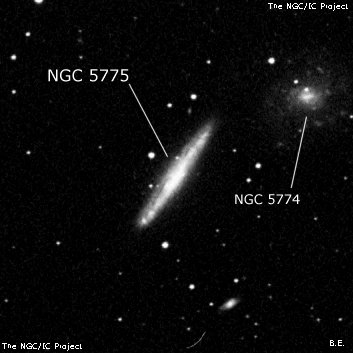
William Herschel discovered NGC 5775 = H III-554 = h1885 on 27 May 1786 (sweep 567) and recorded "vF, S, E from np to sf but nearly in the meridian." JH made 3 observations and first recorded (sweep 143), "Not vF; gvlbM; a narrow ray, 90" l, 15" br." Both Herschel's missed nearby NGC 5774, which was discovered at Birr Castle. Brightest member of GCG 387 (Garcia Compact Group).
400/500mm - 17.5" (4/13/91): fairly bright, moderately large, elongated 3:1 NW-SE, weakly concentrated to a large elongated brighter central region. A mag 13 star is just northeast of the core 0.9' from center. Forms a pair with NGC 5774 4.5' NW.
600/800mm - 24" (7/14/15 and 6/23/17): at 375x; bright, fairly large, very elongated 4:1 NW-SE, 3.6'x0.9', slightly brighter elongated middle. This edge-on has a mottled, dusty appearance. A slightly brighter patch is at the southeast end (HII region "A" in "NGC 5775: Anatomy of a disk-halo interface"). Also, there appears to be a slightly brighter patch on the northwest side. A mag 13.5 star lies 0.9' NE of center. Brightest in a physical trio with NGC 5774 4.4' NW and IC 1070 3.9' SSW.
900/1200mm - 48" (4/19/17): very bright, large, very elongated 5:1 NW-SE, 4.0'x0.8', Contains a larger brighter middle section but no distinct nucleus. A well defined, long thin dust lane slices through much of the galaxy, just east of center, though the contrast is less towards the outer portions. The section west of the lane is considerably brighter and contains the main central section. Overall, the galaxy has a very irregular surface brightness and is generally mottled. The galaxy appears dusty with a lower surface brightness to the northwest of the central section and a knotty section is at the northwest end (identified as [LED2001] C in SIMBAD from the 2001 paper "NGC 5775: Anatomy of a disk-halo interface"). Similarly, there is a lower surface brightness region (dust) southeast of the central section and two very small HII knots near the southeast end (HII complex [LED2001] A). NGC 5775 is the brightest and largest in a trio with NGC 5775 4.4' NW and IC 1070 4' SSW.
Notes by Steve Gottlieb